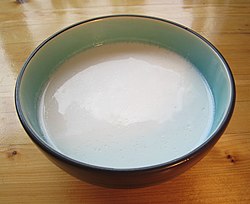**Nutritional Information**:
– Coconut milk contains 230 kilocalories per 100 ml portion.
– Composition: 68% water, 24% total fat, 6% carbohydrates, and 2% protein.
– Saturated fat: 21 grams of total fat content.
– Rich source of manganese (44% DV), phosphorus, iron, and magnesium.
– Other nutrients in insignificant amounts.
**Preparation and Types**:
– Coconut milk made by grating mature coconut flesh and mixing with hot water.
– Divided into coconut cream and thin coconut milk based on fat content.
– Coconut cream from first pressings of grated coconut pulp.
– Thin coconut milk from subsequent pressings with added hot water.
**Uses and Production**:
– Used in cooking across various regions like Southeast Asia, Oceania, and the Caribbean.
– Different types include coconut cream, milk, and skim milk.
– Extracted from grated coconut pulp with gravity separation for cream and skim milk.
– Spoils quickly due to lipid oxidation and lipolysis.
**Processed Products and Variants**:
– Processed coconut milk products using mechanical extraction for longer shelf life.
– Coconut milk powder: dehydrated cream with extended shelf life, easily reconstituted.
– Coconut skim milk: low-fat byproduct increasingly used in food products.
– Milk substitutes: lower fat and calorie content, often fortified with vitamins and minerals.
**Cultural Significance and Health Implications**:
– Culinary uses in traditional dishes like rendang, nasi lemak, and ginataán.
– Coconut milk in beverages like cendol, batida de côco, and piña colada.
– High saturated fat content and its impact on cholesterol levels.
– Historical and cultural significance in various cuisines and traditional recipes.
– Health implications related to saturated fat consumption and dietary guidelines.
Coconut milk is an opaque, milky-white liquid extracted from the grated pulp of mature coconuts. The opacity and rich taste of coconut milk are due to its high oil content, most of which is saturated fat. Coconut milk is a traditional food ingredient used in Southeast Asia, Oceania, South Asia, and East Africa. It is also used for cooking in the Caribbean, tropical Latin America, and West Africa, where coconuts were introduced during the colonial era.
 | |
| Region or state | Traditional: Southeast Asia, Oceania, South Asia, East Africa Introduced: Caribbean, tropical Latin America, West Africa |
|---|---|
| Main ingredients | Coconut |
Coconut milk is differentiated into subtypes based on fat content. They can be generalized into coconut cream (or thick coconut milk) with the highest amount of fat; coconut milk (or thin coconut milk) with a maximum of around 20% fat; and coconut skim milk with negligible amounts of fat. This terminology is not always followed in commercial coconut milk sold in Western countries.
Coconut milk can also be used to produce milk substitutes (differentiated as "coconut milk beverages"). These products are not the same as regular coconut milk products which are meant for cooking, not drinking. A sweetened, processed, coconut milk product from Puerto Rico is also known as cream of coconut. It is used in many desserts and beverages like the piña colada, though it should not be confused with coconut cream.
